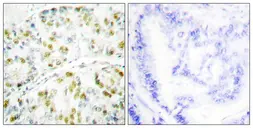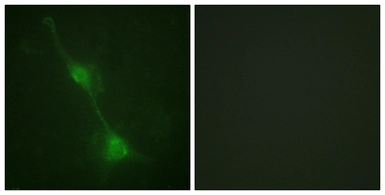APPLICATION
Application Note
*Optimal dilutions/concentrations should be determined by the researcher.
| Application |
Recommended Dilution |
| 1:100~1:500 |
| 1:50~1:100 |
Not tested in other applications.
Calculated MW
PROPERTIES
Form
Liquid
Buffer
PBS (without Mg²⁺ and Ca²⁺) pH7.4, 150mM NaCl, 50% Glycerol
Preservative
0.02% Sodium azide
Storage
Store as concentrated solution. Centrifuge briefly prior to opening vial. For short-term storage (1-2 weeks), store at 4ºC. For long-term storage, aliquot and store at -20ºC or below. Avoid multiple freeze-thaw cycles.
Concentration
Batch dependent (Please refer to the vial label for the specific concentration.)
Antigen Species
Human
Immunogen
The antiserum was produced against synthesized peptide derived from human Ataxin 1 (742-791).
Purification
Purified by antigen-affinity chromatography
From serum
Conjugation
Unconjugated
Note
For laboratory use only. Not for any clinical, therapeutic, or diagnostic use in humans or animals. Not for animal or human consumption.
TARGET
Synonyms
ATX1 , ATXN1 , D6S504E , SCA1 , ataxin 1 , Ataxin 1
Cellular Localization
Cytoplasm,Nucleus
Background
The autosomal dominant cerebellar ataxias (ADCA) are a heterogeneous group of neurodegenerative disorders characterized by progressive degeneration of the cerebellum, brain stem and spinal cord. Clinically, ADCA has been divided into three groups: ADCA types I-III. ADCAI is genetically heterogeneous, with five genetic loci, designated spinocerebellar ataxia (SCA) 1, 2, 3, 4 and 6, being assigned to five different chromosomes. ADCAII, which always presents with retinal degeneration (SCA7), and ADCAIII often referred to as the `pure' cerebellar syndrome (SCA5), are most likely homogeneous disorders. Several SCA genes have been cloned and shown to contain CAG repeats in their coding regions. ADCA is caused by the expansion of the CAG repeats, producing an elongated polyglutamine tract in the corresponding protein. The expanded repeats are variable in size and unstable, usually increasing in size when transmitted to successive generations. The function of the ataxins is not known. This locus has been mapped to chromosome 6, and it has been determined that the diseased allele contains 41-81 CAG repeats, compared to 6-39 in the normal allele, and is associated with spinocerebellar ataxia type 1 (SCA1). At least two transcript variants encoding the same protein have been found for this gene. [provided by RefSeq, Jan 2010]
Database
Research Area
DATA IMAGES

|
GTX87190 IHC-P Image
IHC-P analysis of human lung carcinoma tissue using GTX87190 Ataxin 1 antibody. The picture on the right is blocked with the synthesized peptide.
|

|
GTX87190 ICC/IF Image
ICC/IF analysis of NIH3T3 cells using GTX87190 Ataxin 1 antibody. The picture on the right is blocked with the synthesized peptide.
|
REFERENCE
There are currently no references for Ataxin 1 antibody (GTX87190). Be the first to share your publications with this product.
REVIEW
There are currently no reviews for Ataxin 1 antibody (GTX87190). Be the first to share your experience with this product.



